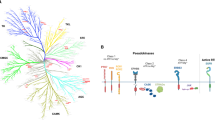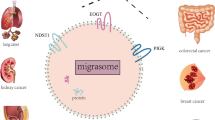Summary
Human glioblastoma cell line A172 expressed protease-activated receptor-1 and -2 (PAR-1 and PAR-2). We investigated the effects of the stimulation of these receptors by receptor-activating agonist peptides on the Ca2+ signaling, protein kinase C translocation, cell morphology and cell proliferation in A172. Both PAR-1 agonist SFLLRN and PAR-2 agonist SLIGKV induced an increase in [Ca2+]i. The prior treatment of A172 with PAR-2 agonist SLIGKV did not influence the [Ca2+]i response to PAR-1 agonist SFLLRN or thrombin, however, the prior treatment with PAR-1 agonist SFLLRN or thrombin completely abolished the second response to PAR-2 agonist SLIGKV. Treatment with each agonist peptide produced thinner and fewer processes in A172. The PAR-2 agonist inhibited the proliferation of A172 significantly while PAR-1 agonist did not. PKC-α and γ were translocated from cytosol to membrane with either PAR-1 or PAR-2 stimulation, however, ı was specifically translocated with SFLLRN, and λ with SLIGKV, respectively. These results indicated that PAR-1 and PAR-2 stimulation produced a similar [Ca2+]i response and morphological changes in A172 glioblastoma while the effects on the cell proliferation and activation of PKC isozymes were distinct, suggesting that different signal transduction pathways were activated by these receptors. The uni-directional cross desensitization implies a functional linkage between PAR-1 and PAR-2 receptors.
Similar content being viewed by others
References
Belham CM, Tate RJ, Scott PH, Pemberton AD, Mller HRP, Wadsworth RM, Gould GW, Plevin R (1996) Trypsin stimulates proteinase-activated receptor-2-dependent and -independent activation of mitogen-activated protein kinases. Biochem J 320: 939–946
Blackhart BD, Emilsson K, Nguyen D, Teng W, Martelli AJ, Nystedt S, Sundelin J, Scarbough RM (1996) Ligand cross-reactivity within the protease-activated receptor family. J Biol Chem 271: 16466–16471
Bono F, Lamarche I, Herbert JM (1997) Induction of vascular smooth muscle cell growth by selective activation of the proteinase activated receptor-2 (PAR-2). Biochem Biophys Res Commun 241: 762–764
Brass L, Molino M (1997) Protease-activated G protein-coupled receptors on human platelets and endothelial cells. Thromb Haemost 78: 234–241
Cavanaugh KP, Gurwitz D, Cunningham DD, Bradshaw RA (1990) Reciprocal modulation of astrocyte stellation by thrombin and protease nexin-1. J Neurochem 54: 1735–1743
Chen Y, Grall D, Salcini AE, Pelicci PG, Pouyssegur J, Van Obberghen-Schilling E (1996) Shc adaptor proteins are key transducers of mitogenic signaling mediated by the G protein-coupled thrombin receptor. EMBO J 15: 1037–1044
Chen ZL, Yoshida S, Kato K, Momota Y, Suzuki J, Tanaka T, Ito J, Nishino H, Aimoto S, Kiyama H, Shiosaka S (1995) Expression and activity-dependent changes of a novel lymbic-serine protease gene in the hippocampus. J Neurosci 15: 5088–5097
Coughlin SR (1994) Protease-activated receptors start a family. Proc Natl Acad Sci USA 90: 9200–9202
Dery O, Corvera CU, Steinhoff M, Bunnett NW (1998) Proteinase-activated receptors: novel mechanisms of signaling by serine proteases. Am J Physiol 274: C1429–1452
Dihanich M, Spiess M (1994) A novel serine proteinase-like sequence from human brain. Biochim Biophys Acta 1218: 225–228
Dihanich M, Kaser M, Reinhard E, Cunningham D, Monard D (1991) Prothrombin mRNA is expressed by cells of the nervous system. Neuron 6: 575–581
Even-Ram S, Uziely B, Cohen P, Grisaru-Granovsky S, Moaz M, Ginzburg Y, Reich R, Vlodavsky, Bar-Shavit R (1998) Thrombin receptor overexpression in malignant and physiological invasion processes. Nature Med 4: 909–914
Gschwend TP, Krueger SR, Koziov SV, Wolfer DP, Sonderegger P (1997) Neurotrypsin, a novel multidomain serine protease expressed in the nervous system. Mol Cell Neurosci 9: 207–219
Gurwitz D, Cunningham D (1988) Thrombin modulates and reverses neuroblastoma neurite outgrowth. Proc Natl Acad Sci USA 85: 3440–3444
Henrikson KP, Salazar SL, Fenton IIJW, Pentecost BT (1999) Role of thrombin receptor in breast cancer invasiveness. Br J Cancer 79: 401–406
Hollenberg MD, Saiffeddine M, Al-ani B, Kawabata A (1997) Protease-activated receptors: structural requirements for activity, receptor cross-reactivity, and receptor selectivity of receptor-activating peptides. Can J Physiol Pharmacol 75: 832–841
Ishihara H, Connolly AJ, Zeng D, Kahn ML, Zheng YW, Timmons C, Tram T, Coughlin SR (1997) Protease-activated receptor 3 is a second thrombin receptor in humans. Nature 386: 502–506
Kahn ML, Zheng Y-W, Huang W, Bigornia V, Zeng D, Moff S, Farese RV, Tam C, Coughlin SR (1998) A dual thrombin receptor system for platelet activation. Nature 394: 690–694
Kaufmann R, Patt S, Schafberg H, Kalff R, Neupert G, Nowak G (1998) Functional thrombin receptor PAR1 in primary cultures of human glioblastoma cells. Neuroreport 9: 709–712
Kawabata A, Saifeddine M, Al-Ani B, Leblond L, Hollenberg MD (1999) Evaluation of proteinase-activated receptor-1 (PAR1) agonists and antagonists using a cultured cell receptor desensitization assay: activation of PAR2 by PARl-targeted ligands. J Pharmacol Exp Ther 288: 358–370
Liitle SP, Dixon EP, Norris F, Buckley W, Becker GW, Johnson M, Dobbins JR, Wyrick T, Miller JR, MacKeller W, Hepburn D, Corvalan J, McClure D, Liu X, Stephenson D, Clemens J, Johnstone EM (1997) Zyme, a novel and potentially amyloidogenic enzyme cDNA isolated from Alzheimer’s disease brain. J Biol Chem 272: 25135–25142
Mirza H, Yatsula V, Bahou WF (1996) The proteinase activated receptor-2 (PAR-2) mediates mitogenic responses in human vascular endothelial cells: molecular characterization and evidence for functional coupling to the thrombin receptor. J Clin Invest 97: 1705–1714
Molino M, Woolkalis MJ, Reavey-Cantwell J, Pratico D, Andrade-Gordon P, Barnathan ES, Brass LF (1997) Endothelial cell thrombin receptors and PAR-2: two protease-activated receptors located in a single cellular environment. J Biol Chem 272:11133–11141
Monard D (1988) Cell-derived proteases and protease inhibitors as regulators of neurite outgrowth. Trends Neurosci 11: 541–544
Nelson RB, Siman R (1990) Thrombin and its inhibitors regulate morphological and biochemical differentiation of astrocytes in vitro. Dev Brain Res 54: 93–104
Nierodzik ML, Chen K, Takeshita K, Li JJ, Huang YQ, Feng XS, D’Andrea MR, Andrade-Gordon P, Karpatkin S (1998) Protease-activated receptor 1 (PAR-1) is required and rate-limiting for thrombin-enhanced experimental pulmonary metastasis. Blood 92: 3694–3700
Nishibori M, Cham B, McNicol A, Shalev A, Jain N, Gerrard JM (1993) The protein CD63 is in a patient with Hermansky-Pudlak syndrome and appears identical to granulophysin. J Clin Invest 91: 1775–1782
Nishizuka Y (1992) Intracellular signaling by hydrolysis of phospholipids and activation of protein kinase C. Science 258: 607–614
Nystedt S, Emilsson K, Wahlestedt C, Sundelin J (1994) Molecular cloning of a potential proteinase activated receptor. Proc Natl Acad Sci USA 91: 9208–9212
Ofosu FA, Freedman J, Dewar L, Song Y, Fenton JW (1998) A trypsin-like platelet protease propagates protease-activated receptor-1 cleavage and platelet activation. Biochem J 336: 283–285
Rasmussen UB, Vouret-Craviari V, Jallat S, Schlesinger Y, Pages G, Pavirani A, Lecocq J-P, Pouyssegur J, Obberghen-Schilling EV (1991) CDNA cloning and expression of a hamster Éø-thrombin receptor coupled to Ca2+ mobilization. FEBS Lett 288: 123–128
Saifeddine M, Al-Ani B, Cheng C-H, Wang L, Hollenberg MD (1996) Rat proteinase-activated receptor-2 (PAR-2): cDNA sequence and activity of receptor-derived peptides in gastric and vascular tissue. Br J Pharmacol 118: 521–530
Sawada K, Nishibori M, Nakaya N, Wang Z, Saeki K (2000) Purification and characterization of a trypsin-like serine proteinase from rat brain slices that degrades laminin and type IV collagen and stimulates protease-activated receptor-2. J Neurochem 74: 1731–1738
Shapiro MJ, Trejo J, Zeng D, Coughlin SR (1996) Role of thrombin receptor’s cytoplasmic tail in intracellular trafficking. J Biol Chem 271: 32874–32880
Shirai Y, Sakai N, Saito N (1998) Subspecies-specific targeting mechanism of protein kinase C. Jpn J Pharmacol 78: 411–417
Smith-Swintosky VL, Zimmer S, Fenton JW II, Mattson MP (1995) Protease nexin-1 and thrombin modulate neuronal Ca2+ homeostasis and sensitivity to glucose deprivation-induced injury. J Neurosci 15: 5840–5850
Smith-Swintosky VL, Cheo-Isaacs CT, D’Andrea MR, Santulli RJ, Darrow AL, Andrade-Gordon P (1997) Protease-activated receptor-2 (PAR-2) is present in the rat hippocampus and is associated with neurodegeneration. J Neurochem 69: 1890–1896
Suidan HS, Stone SR, Hemmings BA, Monard D (1992) Thrombin causes neurite retraction in neuronal cells through activation of cell surface receptors. Neuron 8: 363–375
Tapparelli C, Metternich R, Ehrhardt C, Cook NS (1993) Synthetic low-molecular weight thrombin inhibitors: molecular design and pharmacological profile. Trends Pharmacol Sci 14: 366–376
Trejo J, Connolly AJ, Coughlin SR (1996) The cloned thrombin receptor is necessary and sufficient for activation of mitogen-activated protein kinase and mitogenesis in mouse lung fibroblasts: loss of responses in fibroblasts from receptor knockout mice. J Biol Chem 271: 21536–21541
Ubl JJ, Vohringer C, Reiser G (1998) Co-existence of two types of [Ca2+]-inducing protease-activated receptors (PAR-1 and PAR-2) in rat astrocytes and C6 glioma cells. Neuroscience 86: 597–609
Vaughan PJ, Pike CJ, Cotman CW, Cunningham DD (1995) Thrombin receptor activation protects neurons and astrocytes from cell death produced by environmental insults. J Neurosci 15: 5389–5401
Vu T-KH, Hung DT, Wheaton, VI, Coughlin SR (1991) Molecular cloning of a functional thrombin receptor reveals a novel proteolytic mechanism of receptor activation. Cell 64: 1057–1068
Weinstein JR, Gold SJ, Cunningham DD, Gall CM (1995) Cellular localization of thrombin receptor mRNA in rat brain: expression by mesencephalic dopaminergic neurons and codistribution with prothrombin mRNA. J Neurosci 15: 2906–2919
Wiegand U, Corbach S, Minn A, Kang J, Muller-Hill B (1993) Cloning of the cDNA encoding human brain trypsinogen and characterization of its product. Gene 136: 167–175
Xu W-F, Andersen H, Whitmore TE, Presnell SR, Yee DP, Ching A, Gilbert T, Davie EW, Foster DC (1998) Cloning and characterization of human protease-activated receptor 4. Proc Natl Acad Sci 95: 6642–6646
Yamashiro K, Tsuruoka N, Kodama S, Tsujimoto M, Yamamura Y, Tanaka T, Nakazato H, Yamaguchi N (1997) Molecular cloning of a novel trypsin-like serine protease (neurosin) preferentially expressed in brain. Biochim Biophys Acta 1350: 11–14
Author information
Authors and Affiliations
Rights and permissions
About this article
Cite this article
Okamoto, T., Nishibori, M., Sawada, K. et al. The effects of stimulating protease-activated receptor-1 and -2 in A172 human glioblastoma. J Neural Transm 108, 125–140 (2001). https://doi.org/10.1007/s007020170083
Received:
Accepted:
Issue Date:
DOI: https://doi.org/10.1007/s007020170083




